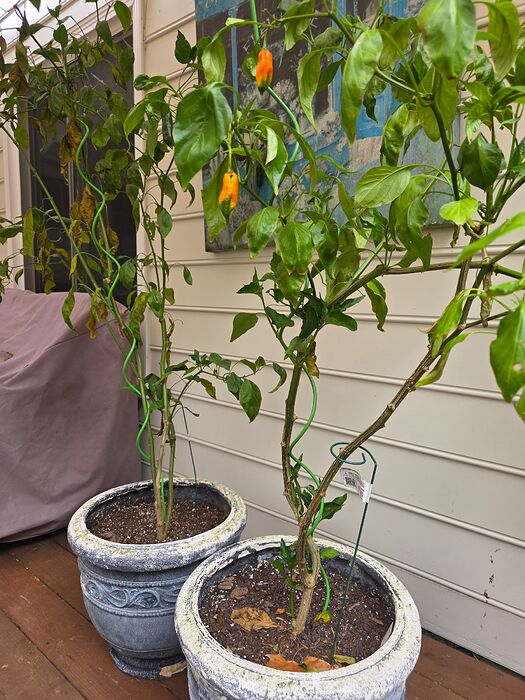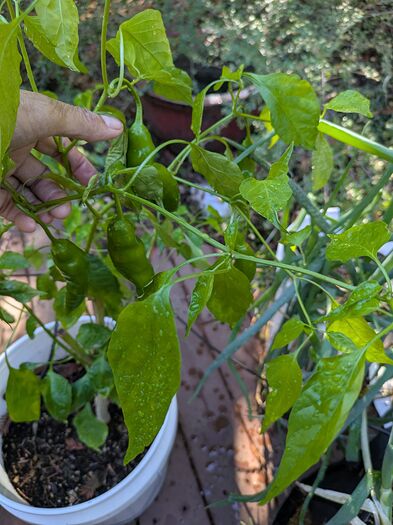I generally dry at low heat (e.g.: 110°F) until brittle. Some peppers remain a bit flexible, even when totally dry. If stored frozen, flexible is ok for most types. But, if flexible means moisture is present, the dried pods aren’t completely dry and can grow mold at room temperature. That’s why I shoot for brittle. I also vacuum-seal the mason jars with oxygen absorbers, for extra long-term storage without loss of quality.
Overwintered pepper plants June 5th; Aji Amarillo on the right in front and rear . I hope I get some peppers from it! I didn’t start new plants. Fresno on the left, second from the front (Scotch Bonnet) was already making peppers last week .
FYI- One of the Sugar Rush Peach plants I planted a year or two back is alive and fruiting. We’ve had a run of really hot weather this summer, mostly over 100, it was 114 last week, and dry- talking a lot of single-digit humidity. The one that survived was in a pot with moisture control potting soil, but of course needed watering daily. So they can survive extreme weather if they’ve got a good lot of root structure, the only thing is that they’re unbelievably hot. I’ve been drying and storing them, but neither of us can eat them, and we both have a lot of tolerance for capsaicin heat, especially my husband. I’m guessing that the weather has played a part in that.
Sugar Rush Peach are typically very hot. However, you should be able to remove the white septa “veins”, which if done carefully, will lower the punch. Many Capsicum baccatum varieties concentrate their heat in the core and septa. If you make slices between the septa, they are often mild, with a little heat coming from the knife.
And yes, the hot weather likely increased the amount of capsaicinoids!
Hi Aji Amarillo experts!
I’m getting ready to bring my plants indoors for the winter (photo attached). They have a bit of new growth all over, & in their pots, they’ve grown to approx. 6’ tall.
I’m not sure how far back I can cut/trim them. Any advice? I saw a photo posted in the thread a while back that gives me hope that I can cut as much as I want, but I’m afraid to mess up my plants that finally produced a good amount of peppers this year.
Thanks in advance for your advice!
I don’t call myself an expert but I’ve been growing them for a few years. I usually cut back to two or three “y”s if that makes sense, but I don’t know where or if I got that advice. FWIW, here in Northern California they have survived at least two winters, maybe four! Mine rarely get much more than two feet tall.
Do you mind saying where you garden?
I just put one of mine in a (usually) unheated greenhouse.
Thanks, @shrinkrap. I’m in the Atlanta area, so it can get a bit cold at night. Another question: have you had success growing new plants from clippings?
I am in an airport on my way to Atlanta right now!
I have not tried starting from cuttings; I’d love to hear how that goes if you try it.
Ideally, You won’t cut more than 20% of the top growth off at a time. Plants balance the root system and top growth feeding it. By removing too much top growth, roots are starved and forced to die back. Plants can tolerate this, but it’s not ideal.
Once the plants are semi-dormant, during the shortest days of winter, you can cut another 20% off. Top reduction is best done in steps, gradually. A lot of dead roots can encourage fungal infections. However, Aji plants are reasonably tough, even though their pollen has temperature limits.
I’ll let you know if I have any luck getting new plants to grow from trimming. I tried one back in the summer, & the plant grew while it was in the water - a small pepper even started to grow - but it never developed roots & didn’t last.
We’ve got a little bit of everything in the forecast for Thanksgiving week - no snow, though. Enjoy your visit! Happy Thanksgiving!
Thanks for your advice, @bogman. Because I was pretty conservative w/ it last winter, they grew pretty tall this season. As a result, I was wondering if I could be more aggressive this year & keep the plant at a manageable height during the season. I like the idea of trimming it in stages - appreciate it!





